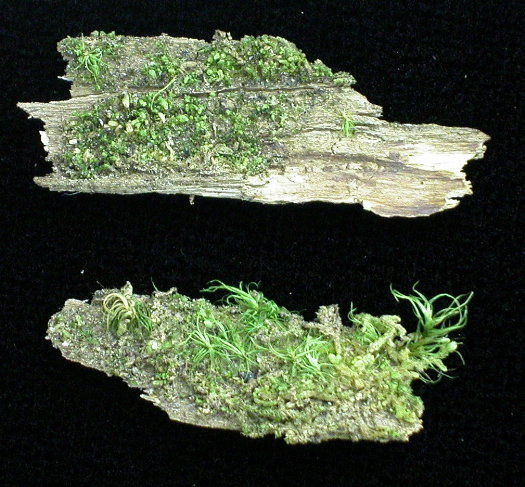Mystery liverwort fungus, chapter two
![]()

Last week, fear won. Making a slide of a mysterious fungus at 4:50 when someone is waiting to be picked up at five o’clock is just too irresponsible an act. Remember this if you are ever in that situation. It is now 3:45 one week later and no-one is waiting tonight. Somewhere among the strata of paper, unopened mail, trade magazines, unreviewed manuscripts and sticky notes beside the computer is that little tin.
click to examine the liverwort
The first time I looked at this specimen with my dissecting microscope, I couldn’t find anything. But now I have found these little devils on the specimen. They are obvious once you have it figured out. They are tiny, only about 50 µm tall (1/20th mm).
Making slides of tiny things is not always easy. Dried specimens are tricky, sometimes so fragile they fall to pieces between the package and the dissecting microscope. Or they are so tough you might need a miniaturized jack hammer remove the fungus from the substrate. Remember tiddly-winks? Many a fungal fruiting body has flipped out of the field of view the moment it is poked with a needle (just one reason not to eat or drink near a microscope).
Our mission is to understand how this fungus is put together. After struggling through the preparation and examination of four slides, here’s what I can tell you. The black pegs could be things called synnemata (the word means ‘together, thread’, so a bundle of hyphae). They start off like an upside-down ice cream cone and expand into a cylinder. The spore-producing cells seem to emerge from the inside, rather than being produced at the top or along the sides. The distinction is important, because fungi producing spores outside of fruiting bodies were historically classified differently than those producing spores inside. For these tiny kinds of fungi, modern classification is based on how spores are produced. I have only a single photo showing the balloon-like development of a spore on the end of a cell (inset photo)–not a lot to go on. The few spores I found (two are around the top of the synnema on the inset photo) are single celled, rod-shaped, and measure 4-6 x 1-1.5 µm. If you lined them up end to end, there would be about 200 of them in a millimeter.
 Sometimes when you are asked to identify something, you just know what it is (see our Blewit eaters post). This exciting event is like immediately recognizing a person you have never seen before, but somewhere you heard about them or saw a picture. You don’t need to measure the length of their nose or examine their eye or hair color, you just know who they are. But when this spark doesn’t happen, you need to do the grunt work; make the slides, take the measurements, take the notes and hope it will lead you somewhere. With this particular fungus, already with the picture from last week, I knew that no key would help me identify this fungus. This is going to be a hard one, and in the end it might be a new genus and species.
Sometimes when you are asked to identify something, you just know what it is (see our Blewit eaters post). This exciting event is like immediately recognizing a person you have never seen before, but somewhere you heard about them or saw a picture. You don’t need to measure the length of their nose or examine their eye or hair color, you just know who they are. But when this spark doesn’t happen, you need to do the grunt work; make the slides, take the measurements, take the notes and hope it will lead you somewhere. With this particular fungus, already with the picture from last week, I knew that no key would help me identify this fungus. This is going to be a hard one, and in the end it might be a new genus and species.
And then what? In today’s brave new world, we like to have DNA sequences to help us classify a fungus in the right group. How do we get DNA from such a tiny fungus? Maybe I’ll be lucky and my molecular wizards will be able to get it directly from the specimen. But first, the sensible thing is to try to isolate a culture. With such a small fungus, this is also a challenge. Cultures take time.
For the next little while, I will be flipping through books and old dusty journals hoping to stumble on something that looks like this fungus. Maybe knowing the liverwort host, Ptilidium pulcherrimum (the species epithet means ‘beautiful’), will lead me to the answer. But if this fungus turns out to be unidentifiable, I’ll have to decide whether to formally describe it, with my Finnish friends, as new to science.
I’ll let you know how it goes. Needless to say, if you know what this fungus is (if you had that exciting, immediate flash of recognition), I’d like to hear from you.
continued in Chapter 3…



[…] To be continued… Editor’s Note: So begins your acquaintance with the Friday Afternoon Mycologist (FAM). The FAM is a waggish friend of the blog, prone to crypticity, and avoidant of the limelight. He is not a made-up person, but actually exists in the physical universe outside the Cornell computosphere. His manifesto provides more clues to his mycological identity. He’ll be chiming in now and then with his curious finds. Stay tuned. […]
[…] Now, our attempt to identify the liverwort fungus (see part 1 and part 2) splits along several parallel paths. […]
I love these accounts of scientific curiosity! Keep ’em coming…
[…] chapter 2, in which the liverwort fungus is found to be vexing […]
[…] chapter 2, in which the liverwort fungus is found to be vexing […]